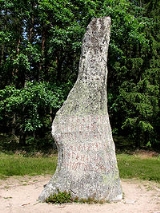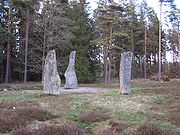
Björketorp Runestone
Encyclopedia
The Björketorp Runestone (DR 360 U
) in Blekinge
, Sweden
, is part of a grave field which includes menhir
s, both solitary and forming stone circles
.
It is one of the world's tallest runestones measuring 4.2 metres in height, and it forms an imposing sight together with two high uninscribed menhirs.

(a similar message is given on the Stentoften Runestone
). It is found on two sides. The shorter message appears to say "I foresee perdition" or "prediction of perdition". The message of the other side is also debated.
Transcription:
Translation:
and the Younger Futhark
. A characteristic example of this is the a-rune which has the same form as the h-rune of the younger futhark. This is the rune that is transliterated with A. The k-rune, which looks like a Y is a transition form between and
which has the same form as the h-rune of the younger futhark. This is the rune that is transliterated with A. The k-rune, which looks like a Y is a transition form between and  in the two futharks. There are quite a few intermediary inscriptions like this one. Three more are known from Blekinge
in the two futharks. There are quite a few intermediary inscriptions like this one. Three more are known from Blekinge
, i.e. the Stentoften Runestone
, the Istaby Runestone
and the Gummarp Runestone
, which was moved to Copenhagen
and lost in the Copenhagen Fire of 1728
.
 The Stentoften, Istaby and Gummarp inscriptions can be identified with the same clan through the names that are mentioned on them, and the names are typical for chieftains. The Björketorp Runestone lacks names and is raised some tens of km from the others. However, it is beyond doubt that the Björketorp runestone is connected to them, because in addition to the special runic forms, the same message is given on the Stentoften Runestone.
The Stentoften, Istaby and Gummarp inscriptions can be identified with the same clan through the names that are mentioned on them, and the names are typical for chieftains. The Björketorp Runestone lacks names and is raised some tens of km from the others. However, it is beyond doubt that the Björketorp runestone is connected to them, because in addition to the special runic forms, the same message is given on the Stentoften Runestone.
It is obvious that the runestones are not carved by the same man, and so it appears that the runestone reflects a specific tradition in Blekinge
during the 7th century. Compared to the Stentoften inscription, the one on the Björketorp stone has a fuller, more formal and less archaic style.
Scholars are not in agreement on the purpose of the runestone. It has been suggested that the runestone is a grave and that the curse is intended to protect it. However, in 1914, there were archaeological excavations which did not present any finds either by the runestone or in the stone circle. To counter this, it has been suggested that the runestone is a Cenotaph
, i.e. a memorial far from the real burial. A second suggestion is that it was a shrine for Odin
or for fertility. A third suggestion is that the runestone marks a border between the Swedes and the Daner
.
Rundata
The Scandinavian Runic-text Data Base is a project involving the creation and maintenance of a database of runic inscriptions. The project's goal is to comprehensively catalog runestones in a machine-readable way for future research...
) in Blekinge
Blekinge
' is one of the traditional provinces of Sweden , situated in the south of the country. It borders Småland, Scania and the Baltic Sea.The name "Blekinge" comes from the adjective bleke, which corresponds to the nautical term for "dead calm"....
, Sweden
Sweden
Sweden , officially the Kingdom of Sweden , is a Nordic country on the Scandinavian Peninsula in Northern Europe. Sweden borders with Norway and Finland and is connected to Denmark by a bridge-tunnel across the Öresund....
, is part of a grave field which includes menhir
Menhir
A menhir is a large upright standing stone. Menhirs may be found singly as monoliths, or as part of a group of similar stones. Their size can vary considerably; but their shape is generally uneven and squared, often tapering towards the top...
s, both solitary and forming stone circles
Stone circle (Iron Age)
The stone circles of the Iron Age were a characteristic burial custom of southern Scandinavia, especially on Gotland and in Götaland during the Pre-Roman Iron Age and the Roman Iron Age. In Sweden, they are called Domarringar , Domkretsar or Domarsäten...
.
It is one of the world's tallest runestones measuring 4.2 metres in height, and it forms an imposing sight together with two high uninscribed menhirs.

Inscription
The runes were made in the 6th or the 7th century and in Proto-NorseProto-Norse language
Proto-Norse was an Indo-European language spoken in Scandinavia that is thought to have evolved as a northern dialect of Proto-Germanic over the first centuries AD...
(a similar message is given on the Stentoften Runestone
Stentoften Runestone
The Stentoften Runestone, listed in the Rundata catalog as DR 357, is a runestone which contains a curse in Proto-Norse that was discovered in Stentoften, Blekinge, Sweden....
). It is found on two sides. The shorter message appears to say "I foresee perdition" or "prediction of perdition". The message of the other side is also debated.
- A: hAidz runo ronu fAlAhAk hAiderA ginArunAz ArAgeu hAerAmAlAusz utiAz welAdAude sAz þAt bArutz
- B: uþArAbA sbA
Transcription:
- A Haidz runo runu, falh'k hedra ginnarunaz. Argiu hermalausz, ... weladauþe, saz þat brytz.
- B Uþarba spa.
Translation:
- A I, master of the runes(?) conceal here runes of power. Incessantly (plagued by) maleficence, (doomed to) insidious death (is) he who breaks this (monument).
- B I prophesy destruction / prophecy of destruction.
Analysis
Most scholars date the inscription to the 7th century and it is carved with a type of runes that form an intermediate version between the Elder FutharkElder Futhark
The Elder Futhark is the oldest form of the runic alphabet, used by Germanic tribes for Northwest Germanic and Migration period Germanic dialects of the 2nd to 8th centuries for inscriptions on artifacts such as jewellery, amulets, tools, weapons and runestones...
and the Younger Futhark
Younger Futhark
The Younger Futhark, also called Scandinavian runes, is a runic alphabet, a reduced form of the Elder Futhark, consisting of only 16 characters, in use from ca. 800 CE...
. A characteristic example of this is the a-rune
 which has the same form as the h-rune of the younger futhark. This is the rune that is transliterated with A. The k-rune, which looks like a Y is a transition form between and
which has the same form as the h-rune of the younger futhark. This is the rune that is transliterated with A. The k-rune, which looks like a Y is a transition form between and  in the two futharks. There are quite a few intermediary inscriptions like this one. Three more are known from Blekinge
in the two futharks. There are quite a few intermediary inscriptions like this one. Three more are known from BlekingeBlekinge
' is one of the traditional provinces of Sweden , situated in the south of the country. It borders Småland, Scania and the Baltic Sea.The name "Blekinge" comes from the adjective bleke, which corresponds to the nautical term for "dead calm"....
, i.e. the Stentoften Runestone
Stentoften Runestone
The Stentoften Runestone, listed in the Rundata catalog as DR 357, is a runestone which contains a curse in Proto-Norse that was discovered in Stentoften, Blekinge, Sweden....
, the Istaby Runestone
Istaby Runestone
The Istaby Runestone, listed in the Rundata catalog as DR 359, is a runestone with an inscription in Proto-Norse which was raised in Istaby, Blekinge, Sweden, during the Vendel era....
and the Gummarp Runestone
Gummarp Runestone
The Gummarp Runestone, designated as DR 358, was a runestone from the Vendel era and which was located in the former village of Gummarp in the province of Blekinge, Sweden.-Description:...
, which was moved to Copenhagen
Copenhagen
Copenhagen is the capital and largest city of Denmark, with an urban population of 1,199,224 and a metropolitan population of 1,930,260 . With the completion of the transnational Øresund Bridge in 2000, Copenhagen has become the centre of the increasingly integrating Øresund Region...
and lost in the Copenhagen Fire of 1728
Copenhagen Fire of 1728
The Copenhagen Fire of 1728 was the largest fire in the history of Copenhagen, Denmark. It began on the evening of October 20, 1728, and continued to burn until the morning of October 23. It destroyed approximately 28% of the city , left 20% of the population homeless, and the reconstruction lasted...
.

It is obvious that the runestones are not carved by the same man, and so it appears that the runestone reflects a specific tradition in Blekinge
Blekinge
' is one of the traditional provinces of Sweden , situated in the south of the country. It borders Småland, Scania and the Baltic Sea.The name "Blekinge" comes from the adjective bleke, which corresponds to the nautical term for "dead calm"....
during the 7th century. Compared to the Stentoften inscription, the one on the Björketorp stone has a fuller, more formal and less archaic style.
Scholars are not in agreement on the purpose of the runestone. It has been suggested that the runestone is a grave and that the curse is intended to protect it. However, in 1914, there were archaeological excavations which did not present any finds either by the runestone or in the stone circle. To counter this, it has been suggested that the runestone is a Cenotaph
Cenotaph
A cenotaph is an "empty tomb" or a monument erected in honour of a person or group of people whose remains are elsewhere. It can also be the initial tomb for a person who has since been interred elsewhere. The word derives from the Greek κενοτάφιον = kenotaphion...
, i.e. a memorial far from the real burial. A second suggestion is that it was a shrine for Odin
Odin
Odin is a major god in Norse mythology and the ruler of Asgard. Homologous with the Anglo-Saxon "Wōden" and the Old High German "Wotan", the name is descended from Proto-Germanic "*Wodanaz" or "*Wōđanaz"....
or for fertility. A third suggestion is that the runestone marks a border between the Swedes and the Daner
Daner
The Danes were a North Germanic tribe residing in modern day Denmark. They are mentioned in the 6th century in Jordanes' Getica, by Procopius, and by Gregory of Tours....
.

